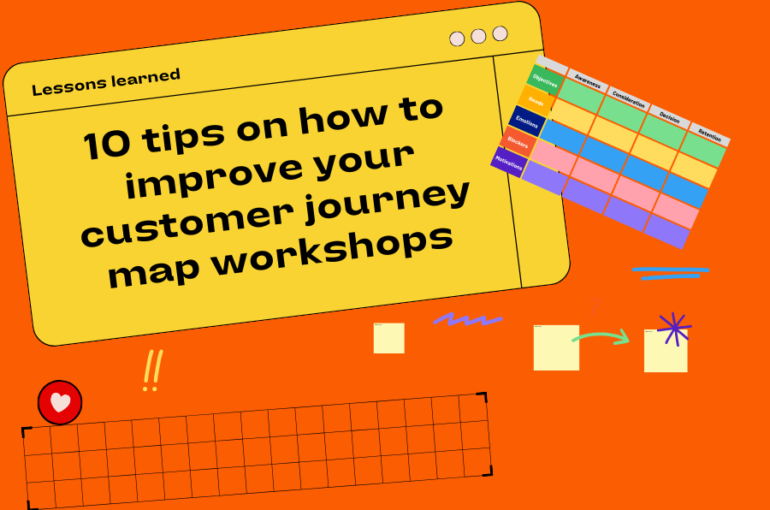10 tips on how to improve your customer journey map workshops
10 tips on how to improve your customer journey map workshops

Have you ever done or participated in a customer journey map workshop? It’s one of my favourite tools to this date — not just because of the creative output you can achieve, but because of the team energy and new synergy you can get out of it. Over the years I’ve done many Customer Journey Map workshops, some of them went really well, others not so much.
In this article, I want to summarize my key lessons learned.

What is a customer journey map?
A customer journey map is a diagram that illustrates the steps your customers go through when engaging with your brand. It provides you with an end-to-end view of the actions a customer is taking, the questions or thoughts they might have, the touchpoints they interact with and their emotional reactions.

Mapping out your customer’s experience helps to uncover pain points and barriers that you can then turn into opportunities for improvement.
It’s a great tool for gaining a big-picture perspective and identifying your next priorities as a business.
If you want to learn more about customer journey maps, here are some great resources:
- Journey Mapping 101 by NNG
- Customer Journey Maps by Interaction Design Foundation
- Customer Journey Map Workshop by Atlassian
Lessons learned
Here are some takeaways that might be useful for anyone who is organizing and facilitating CJM Workshops.
🎯 1. Define the objective and set expectations
Before you start organizing a customer journey map session, get alignment with your client or stakeholders and with your participants. A customer journey map might not always be the right tool to use, so get clear on:
- The intended outcome: the tangible outcomes are a list of ideas for improvements and a visualization of the customer steps and interactions; the intangible outcomes are team alignment and knowledge sharing.
- The problem you are trying to solve: You can start a customer journey map from different perspectives and look at the overall journey (30,000 foot view) or at a detailed task within a journey (1,000 foot view). Be clear on what you need to solve to choose the right level for your map.
- The target audience/ persona and scenario/ task: A customer journey map is done for a specific “persona” or audience group. If you need to cover more than one group, you need multiple maps — and therefore either multiple workshops or a large group that can work on different maps in parallel.
👉 Tip: Use a workshop planning canvas to collect your inputs

👥 2. Get the right participants
One big benefit of a workshop is bringing people with different expertise together who might usually not work together. Think about any customer knowledge holders. While striving for diversity, you want to keep the group size manageable. An ideal group size is between 6–10 people.
Think about your participants based on:
- Who is directly involved in customer touchpoints (sales, customer service…)?
- Who collects customer knowledge behind the scenes (data analyst, marketing…)?
🗒 3. Prepare a research summary document
You want to make sure that your participants are all on the same page and have the knowledge they need for a fruitful participation. Depending on the involvement in any previous research, I like to prepare a brief research summary package to highlight key findings, the persona description, any interesting data and quotes.
In your workshop you want to:
- Include a brief presentation about the main research findings.
- Introduce everyone to the persona and scenario that your customer journey map will be focused on. Use storytelling to create empathy for the customer.
- Share research insights as a document that participants can refer to while working on the map.

👬 4. Work in small groups
The goal of a CJM Workshop is to come up with ideas for opportunities for improvement. You want to create an environment that encourages free and creative thinking. This is best done by having people working in small groups together.
Depending on the situation I like to use one of the two approaches to split people into groups:
- Approach A: Mix people with different backgrounds (i.e. sales, development, marketing) and work on the whole journey
- Approach B: Keep experts together and have each group working on a specific section of the journey (i.e. sales + marketing are working on the beginning section, customer support, works at the last section of the journey)

💁♂️ 5 Have co-facilitators (and prep them)
Group work needs some guidance and encouragement. If you plan to work in smaller groups, make sure to have co-facilitators who can support each group by reminding participants to think from a customer’s perspective (and not to get stuck in false assumptions).
You want to make sure that:
- You have a facilitator for each group
- Your co-facilitators know the research details
- You be clear about the role & responsibility each co-facilitator has (depending on how well you know each other you might want to go through some guiding principles)
💡6. Schedule enough time for ideation
To ensure that you get the juices flowing and collect lots of ideas for improvement (the main outcome of a CJM workshop) I tend to split my workshops into 2 main phases:
- Part 1: This is all about creating or understanding the customer journey, needs and pain points. In this phase, you want to foster discussions that help create empathy and change perspectives.
- After the first phase you come together, share findings or learnings and align on the severity of the pain points
- Part 2: This is the fun part and all about creating lots of ideas for improvement. You want to schedule enough time so that people can think broadly and inspire each other.

👋 7. Schedule enough time for networking
One big intangible outcome and benefit of CJM workshops is bringing “new” people together. If you ensure a diversity of participants you will often end up with people who have never worked with each other. Having an opportunity to share knowledge and learn about each other’s objectives, processes and needs can result in better teamwork outside of the workshop session.
- Schedule enough breaks in between to allow for informal chitchat
- Encourage everyone to speak up and share their opinions
✔️ 8. Wrap up with an action item list
To make the outcome of the workshop as fruitful as possible and ensure that participants feel the value of their engagement, you want to end the workshop with an actionable list of next steps.
- What are the next steps?
- Who is responsible?
- By when?
Sometimes the next step is just a single item, that is aligning on the specific action items or getting buy-in. That’s fine — just make sure that you have at least one specific task you can follow-up on.
📨 9. Send summaries and follow-ups
This leads to the next step: your job as a facilitator isn’t done with the end of the workshop. Make sure to send out a summary shortly after the workshop and include:
- Summarize the main outcomes in one slide
- Photos & documentation
- A list of action items with names of the person that is responsible for it
🤲 10. Make the customer journey map shareable
The customer journey map is an important input for the product roadmap and planning detailed product features. Create a deliverable that can be shared outside of the workshop group and impact future projects. I had the most success with interactive versions (like a Miro board or FigJam) so people can continue to comment or ideate.

Over to you
What are some of your biggest learnings for customer journey map workshops or facilitation in general? What do you want to try differently next time?


